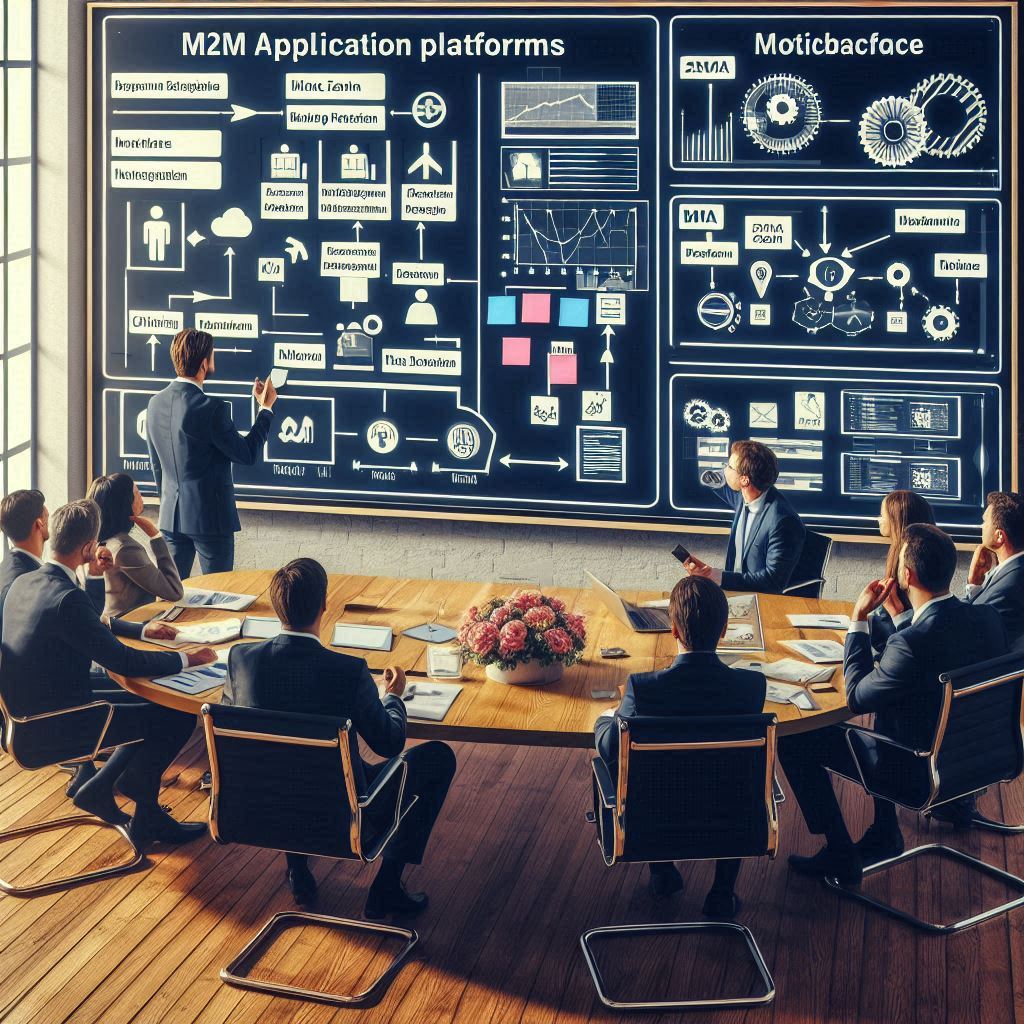What are M2M Application Platforms?
M2M (Machine-to-Machine) application platforms are centralized software systems that facilitate communication and data exchange between connected devices, sensors, and machines. These platforms serve as the backbone of IoT (Internet of Things) ecosystems, enabling seamless integration, management, and control of interconnected devices across various industries.
At their core, M2M application platforms provide the infrastructure and tools necessary to collect, process, and analyze data generated by connected devices. They offer a range of functionalities, including data ingestion, storage, real-time monitoring, analytics, and application development. By leveraging these capabilities, organizations can harness the power of IoT to improve operational efficiency, enhance decision-making, and deliver innovative products and services. 
These platforms are equipped to receive data from diverse sources, including sensors, machines, and other IoT devices. They support various communication protocols and data formats, ensuring compatibility with a wide range of devices.
M2M application platforms provide robust storage solutions to securely store and manage large volumes of data generated by connected devices. They offer scalable databases and data lakes that can accommodate growing data volumes and enable efficient data retrieval and analysis.
These platforms offer real-time monitoring and visualization tools that allow users to track the status and performance of connected devices in real-time. They provide dashboards, alerts, and notifications to help organizations identify issues promptly and take proactive measures to address them.
M2M application platforms include advanced analytics capabilities that enable organizations to derive actionable insights from IoT data. They offer tools for data analysis, machine learning, and predictive analytics, allowing organizations to uncover patterns, trends, and anomalies in their data and make data-driven decisions.
These platforms provide development tools and APIs (Application Programming Interfaces) that enable organizations to build custom applications and integrations on top of the platform. They offer SDKs (Software Development Kits) and developer resources to streamline the application development process and accelerate time-to-market.
M2M application platforms are important in enabling organizations to harness the full potential of IoT technology. They provide the necessary infrastructure, tools, and capabilities to build scalable, secure, and efficient IoT solutions that drive digital transformation and innovation across industries.
The Functionality of M2M Application Platforms
M2M application platforms serve as the central hub for collecting, organizing, and managing data generated by connected devices. These platforms gather data from various sensors, meters, and other devices, ensuring that it is stored securely and made available for analysis.
One of the key functionalities of M2M application platforms is to establish and maintain connectivity between devices. These platforms provide protocols, APIs, and other tools to facilitate communication, enabling seamless data exchange between devices regardless of their location or type.
M2M application platforms offer comprehensive device management capabilities, allowing administrators to monitor and control connected devices remotely. This includes tasks such as device provisioning, configuration, firmware updates, and troubleshooting, all of which can be performed centrally through the platform.
M2M application platforms leverage advanced analytics techniques to derive insights from the data collected from connected devices. By analyzing data patterns, detecting anomalies, and generating reports, these platforms enable organizations to gain valuable insights into their operations, identify trends, and make data-driven decisions.
Benefits of M2M Application Platforms
M2M application platforms streamline processes by automating tasks, optimizing resource allocation, and reducing manual intervention. By enabling real-time monitoring and control of connected devices, these platforms enhance operational efficiency and productivity across various industries.
With access to comprehensive data analytics and insights, organizations can make informed decisions quickly. M2M application platforms provide valuable insights into operational performance, customer behavior, and market trends, empowering decision-makers to take proactive measures and capitalize on emerging opportunities.
By optimizing resource utilization, reducing downtime, and minimizing manual labor, M2M application platforms help organizations save costs in the long run. Improved efficiency leads to lower operational expenses, while predictive maintenance and asset optimization strategies prevent costly equipment failures and unplanned downtime.
M2M application platforms are designed to scale seamlessly as businesses grow and evolve. These platforms can accommodate changing needs without requiring significant reconfiguration or investment in additional infrastructure.
By enabling organizations to deliver personalized services, respond quickly to customer needs, and anticipate preferences, M2M application platforms contribute to an enhanced customer experience. From tailored product recommendations to proactive support and maintenance, these platforms help build stronger customer relationships and foster loyalty.
Challenges and Considerations
M2M application platforms streamline processes by automating tasks, optimizing resource allocation, and reducing manual intervention. By enabling real-time monitoring and control of connected devices, these platforms enhance operational efficiency and productivity across various industries.
With access to comprehensive data analytics and insights, organizations can make informed decisions quickly. M2M application platforms provide valuable insights into operational performance, customer behavior, and market trends, empowering decision-makers to take proactive measures and capitalize on emerging opportunities.
By optimizing resource utilization, reducing downtime, and minimizing manual labor, M2M application platforms help organizations save costs in the long run. Improved efficiency leads to lower operational expenses, while predictive maintenance and asset optimization strategies prevent costly equipment failures and unplanned downtime.
M2M application platforms are designed to scale seamlessly as businesses grow and evolve. These platforms can accommodate changing needs without requiring significant reconfiguration or investment in additional infrastructure.
By enabling organizations to deliver personalized services, respond quickly to customer needs, and anticipate preferences, M2M application platforms contribute to an enhanced customer experience. From tailored product recommendations to proactive support and maintenance, these platforms help build stronger customer relationships and foster loyalty.
